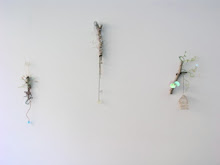Recently, Marilla Palmer wrote, "I feel a very powerful connection to raw, unspoiled nature and my spiritual orientation is almost pagan."
Indeed, many of the pieces in this show began with twigs, vines, flowers, and fungi that she gathered near her two family homes--one in Falls Village, Connecticut, and the other in Greenpoint, Brooklyn. And their titles are often drawn from Emily Dickinson's paean to nature, "I taste a liquor never brewed."
Yet nature always seems to travel hand in hand with artifice in Marilla's work--and the pieces here are no exception. To make them, she has transformed her flora with fabricated elements, such as ribbons, beads, and feathers. Because she finds many of these adornments on her travels, or around the house, one might say that her artistry is rooted in some very basic natural instincts: hunting, gathering, and decorating.
Marilla began the pieces here about two years ago, when she began experimenting with some squares of Astroturf left over from another project. She planted two with plastic and glass flowers, and embroidered the third with a spider's web made from glass seed beads, then set artificial dragonflies hovering on wires above it.
Her aim soon became "to make a quilt that was also a landscape," she says. "Something that would give the feeling of lying down in nature--but fabricated."
Gradually, she added other bits and pieces scavenged from boxes and closets around her home--ribbons, brocades, wool bouclé, and even a swatch of fabric she designed herself. This silky, tufted landscape grew into the wall hanging "Debauchee of Dew."
Partway through making this piece, Marilla felt impelled to gather up wet, broken twigs from trees near the Connecticut lake where she and her family swim each summer. At first, she says, "I didn't know what I was going to be doing, but I knew I definitely wanted to pick up little pieces of trees." Once they had dried out, she covered a few with iridescent glitter, and her magpie instincts took over.
The twig at the heart of "Molten Blue Dew" now sprouts green Mylar leaves and turquoise and brown beaded vines. The branch in "Snowy Hats" bears a crop of Mylar fungi, and a silver dragonfly hangs by a chain from its flower-bedecked rhinestone vines. In "Out of the Foxglove's Door," a thorny rose vine culled from Marilla's Brooklyn back yard is entwined with green and hot pink beads. Hovering near its roots are speckled feathers (found in Barbados), and a tiny house of golden wire dangles from its tip. "It's like having a home in nature," Marilla says, "and the home is open to nature." In all these pieces, the Mylar leaves and petals cast dappled pink shadows against the wall.
For the most part, Marilla's interventions have a strange effect; it's as though she has coaxed these bits of flora into the sublime, exalted place that nature often occupies in the imagination. Something similar happens in her collages, too. In these faux botanical illustrations, pressed flowers and blossom-like mushroom prints are subtly enhanced with watercolor and holographic paper, to the point that it's hard to tell where nature ends and the woman-made takes over.
Towards the summer's end, Marilla turned her gathering to the streets of Greenpoint, her grittily industrial New York neighborhood. That's where she found the battered black workman's glove that now appears to sprout from a sparkling toadstool in "Inebriate of Air Am I." Transformed by blue glitter, sequins, beads, and Mylar leaves, it suggests the ornate gauntlets worn by Jean Marais in Jean Cocteau's 1946 film "La Belle et La Bête," or perhaps Michael Jackson's single sequined glove. Part show biz, part Surrealist, it seems to beckon the viewer into a better world, where Mother Nature has been primped, primed, and gussied up to become all that She should be.
text © Carol Kino
images © Marilla Palmer
IF YOU HAVE ROOM FOR MY ID and Marilla's CV or bio . . . .
Carol Kino is a contributing editor at Art & Auction and a frequent contributor to The New York Times and Town & Country. Her stories have also appeared in a wide range of publications, including Vogue, Slate, The Atlantic Monthly, Art in America, and Modern Painters.
fringe installation

Put Your Ear Down, The Silk CAve

Inebriate of Air am I

Trumpet Vine Radicans

Put Your Ear Down

Debauchee of Dew, Out of the Foxgloves Door

Debauchee of Dew

Moonlight House

Tree House

Orange Sunshine

Molten Blue Dew

Their Snowy Hats

Three collages

framed collages

Molten blue Dew, Their Snowy Hats, Tree House

No comments:
Post a Comment